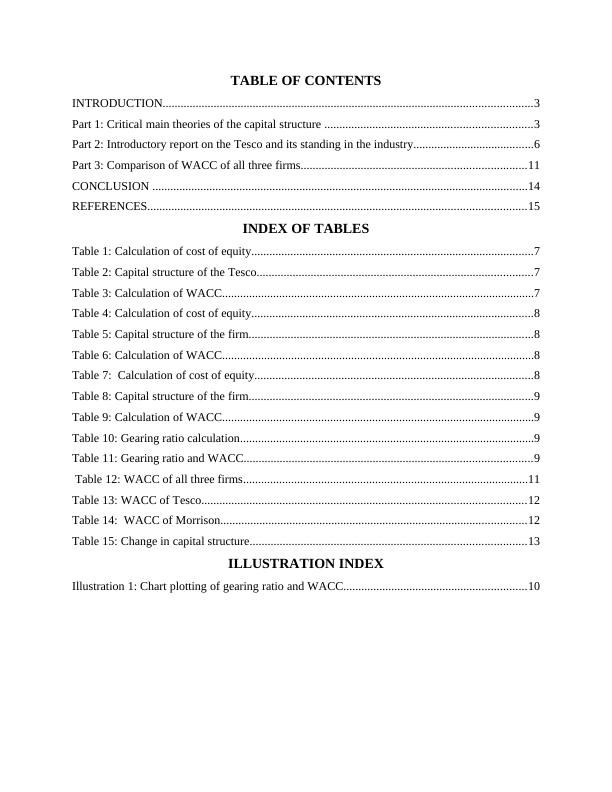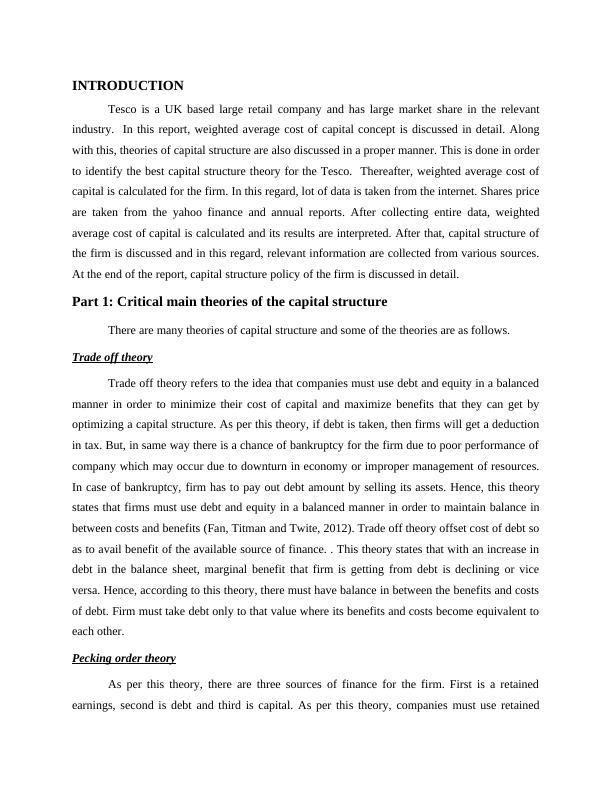Capital Structure Theory For TESCO
Added on 2020-01-23
17 Pages5254 Words1246 Views
CORPORATE FINANCE

TABLE OF CONTENTSINTRODUCTION...........................................................................................................................3Part 1: Critical main theories of the capital structure .....................................................................3Part 2: Introductory report on the Tesco and its standing in the industry........................................6Part 3: Comparison of WACC of all three firms...........................................................................11CONCLUSION .............................................................................................................................14REFERENCES..............................................................................................................................15INDEX OF TABLESTable 1: Calculation of cost of equity..............................................................................................7Table 2: Capital structure of the Tesco............................................................................................7Table 3: Calculation of WACC........................................................................................................7Table 4: Calculation of cost of equity..............................................................................................8Table 5: Capital structure of the firm...............................................................................................8Table 6: Calculation of WACC........................................................................................................8Table 7: Calculation of cost of equity.............................................................................................8Table 8: Capital structure of the firm...............................................................................................9Table 9: Calculation of WACC........................................................................................................9Table 10: Gearing ratio calculation..................................................................................................9Table 11: Gearing ratio and WACC................................................................................................9Table 12: WACC of all three firms...............................................................................................11Table 13: WACC of Tesco............................................................................................................12Table 14: WACC of Morrison......................................................................................................12Table 15: Change in capital structure............................................................................................13ILLUSTRATION INDEXIllustration 1: Chart plotting of gearing ratio and WACC.............................................................10

INTRODUCTIONTesco is a UK based large retail company and has large market share in the relevantindustry. In this report, weighted average cost of capital concept is discussed in detail. Alongwith this, theories of capital structure are also discussed in a proper manner. This is done in orderto identify the best capital structure theory for the Tesco. Thereafter, weighted average cost ofcapital is calculated for the firm. In this regard, lot of data is taken from the internet. Shares priceare taken from the yahoo finance and annual reports. After collecting entire data, weightedaverage cost of capital is calculated and its results are interpreted. After that, capital structure ofthe firm is discussed and in this regard, relevant information are collected from various sources.At the end of the report, capital structure policy of the firm is discussed in detail.Part 1: Critical main theories of the capital structure There are many theories of capital structure and some of the theories are as follows.Trade off theoryTrade off theory refers to the idea that companies must use debt and equity in a balancedmanner in order to minimize their cost of capital and maximize benefits that they can get byoptimizing a capital structure. As per this theory, if debt is taken, then firms will get a deductionin tax. But, in same way there is a chance of bankruptcy for the firm due to poor performance ofcompany which may occur due to downturn in economy or improper management of resources.In case of bankruptcy, firm has to pay out debt amount by selling its assets. Hence, this theorystates that firms must use debt and equity in a balanced manner in order to maintain balance inbetween costs and benefits (Fan, Titman and Twite, 2012). Trade off theory offset cost of debt soas to avail benefit of the available source of finance. . This theory states that with an increase indebt in the balance sheet, marginal benefit that firm is getting from debt is declining or viceversa. Hence, according to this theory, there must have balance in between the benefits and costsof debt. Firm must take debt only to that value where its benefits and costs become equivalent toeach other.Pecking order theoryAs per this theory, there are three sources of finance for the firm. First is a retainedearnings, second is debt and third is capital. As per this theory, companies must use retained

earnings first of all in order to finance its operation as this source of finance does not have anycost of capital. Moreover, it is a type of money that is earned by the firm and it is theresponsibility of firm to make use of that fund wisely. Hence, in order to fulfill company’sfinance requirements, first of all managers must use retained earnings and by doing same, theycan prevent elevation in the firm’s cost of capital. Due to this reason, retained earnings isproposed to be the source of finance that must be used first by the business managers. Afterretained earnings, debt is taken as a source of finance in the theory (Hillier, Grinblatt andTitman, 2011). As per this theory, debt must be used secondly because for taking debt, companyhas to make payment of interest as a cost of capital of debt. If, it is taken at the floating interestrate then there will be great chance of elevation in the finance cost due to fluctuation in currencyand interest rate by the central bank. This happens when loan is taken in the foreign currency.Due to this flexible interest rate, many times cost of firm get increased and debt burden becomesheavy on the firm. Hence, in order to prevent this situation, debt is preferred as a source offinance after retained earnings. Finally, in the theory, equity is taken as a source of finance on thethird position. By considering both debt and equity, it can be seen that both have positive andnegative points over each other (Chen, 2010). In case of debt, shareholding can be retained to alarge extent by the real owners of firm. But cost of finance cannot be kept lower in case of thissource of finance. On other hand, in case of equity cost, finance can be controlled to a largeextent but ownership cannot be retained fully. In this theory, control of real owners on the firm isgiven prime importance. Due to this reason, equity is kept at the third place as a source offinance. If majority of stake of the company will be sold to the small and large stakeholders thenit will be difficult for the main decision makers to take core business decisions. By consideringthese factors, retained earnings, debt and equity are kept in first second and third position as theproffered source of finance.Modigliani miller theoryThis is a unique theory and totally different from the traditional theories. As per thistheory, capital structure mix that is used by firm in order to finance company operations does notaffect company value. Modigliani and miller state that market value of the firm is determined bythe earning power and risk that are associated with the underlying asset (Margaritis and Psillaki,2010). This theory is based on some of the assumptions like there is no tax on economy followedby non-transaction cost and bankruptcy cost etc. As per this theory, valuation of the firm is not

End of preview
Want to access all the pages? Upload your documents or become a member.
Related Documents
Calculation of WACC, Gearing Ratio, and Capital Structure Theory: A Corporate Finance Analysislg...
|9
|2091
|206
Capital Structure of Nufarm Limitedlg...
|15
|3358
|124
Corporate Finance Fundamentalslg...
|16
|2810
|87
WACC - Corporate Financelg...
|16
|4795
|198
Calculation of Weighted Average Cost of Capital and Gearing Ratios of SingTel and StarHublg...
|17
|2725
|478
ASSIGNMENT ON CAPITAL STRUCTURE ANALYSIS.lg...
|14
|2948
|28
